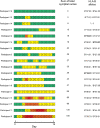This is a preprint.
Lack of association between HLA and asymptomatic SARS-CoV-2 infection
- PMID: 38168184
- PMCID: PMC10760282
- DOI: 10.1101/2023.12.06.23299623
Lack of association between HLA and asymptomatic SARS-CoV-2 infection
Update in
-
Lack of association between classical HLA genes and asymptomatic SARS-CoV-2 infection.HGG Adv. 2024 Jul 18;5(3):100300. doi: 10.1016/j.xhgg.2024.100300. Epub 2024 Apr 26. HGG Adv. 2024. PMID: 38678364 Free PMC article.
Abstract
Human genetic studies of critical COVID-19 pneumonia have revealed the essential role of type I interferon-dependent innate immunity to SARS-CoV-2 infection. Conversely, an association between the HLA-B*15:01 allele and asymptomatic SARS-CoV-2 infection in unvaccinated individuals was recently reported, suggesting a contribution of pre-existing T cell-dependent adaptive immunity. We report a lack of association of classical HLA alleles, including HLA-B*15:01, with pre-omicron asymptomatic SARS-CoV-2 infection in unvaccinated participants in a prospective population-based study in the US (191 asymptomatic vs. 945 symptomatic COVID-19 cases). Moreover, we found no such association in the international COVID Human Genetic Effort cohort (206 asymptomatic vs. 574 mild or moderate COVID-19 cases and 1,625 severe or critical COVID-19 cases). Finally, in the Human Challenge Characterisation study, the three HLA-B*15:01 individuals infected with SARS-CoV-2 developed symptoms. As with other acute primary infections, no classical HLA alleles favoring an asymptomatic course of SARS-CoV-2 infection were identified. These findings suggest that memory T-cell immunity to seasonal coronaviruses does not strongly influence the outcome of SARS-CoV-2 infection in unvaccinated individuals.
Figures



References
Publication types
Grants and funding
LinkOut - more resources
Full Text Sources
Research Materials
Miscellaneous
